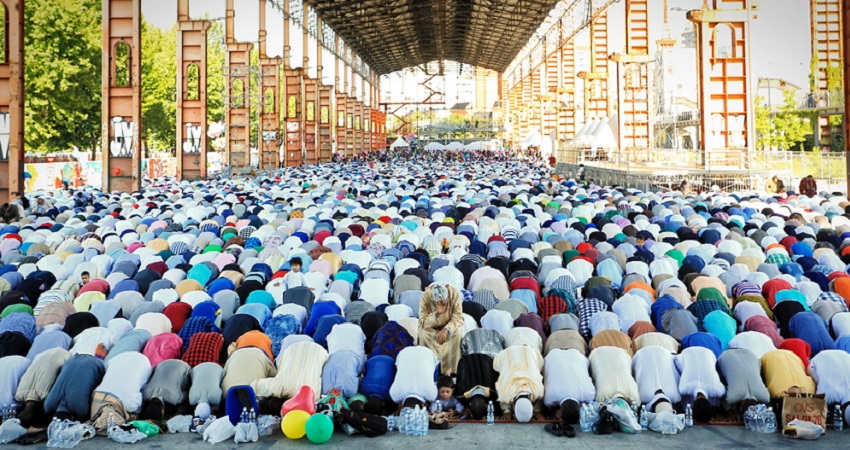The word ‘Eid’ is a derivation of the Arabic word ‘Owd’ which means to return or come back. Eid prayer or Eid salah is performed on the day of Eid. The notion behind performing Eid salah is to display gratefulness to Allah for blessing people with the month of Ramadan and giving people the ability to do Ibadah during the holy month. The second understanding behind Eid Salah is to begin the day with the dutifulness to Allah SWT as Islam directs its people to not engage in any kind of bad deed or disobedience during the days of the celebration. Thus, everybody comes together to offer Eid Salah on the day of Eid by being obedient to the deity.
In this blog we look at various aspects of Eid prayer, including
- Eid prayer importance
- Eid prayer method and Eid prayer takbeer
- Eid prayer timings
- Eid fasting
- Eid traditions
Importance of Eid prayer
Eid prayers are offered in the congregation with the company of family, friends, and other Muslims. The prayers are a way to show gratitude to Allah and bring a feeling of belongingness and brotherhood among Muslims worldwide. In addition, the prayers have a direct impact on an individual’s life and assist in achieving excellent results and rewards.
What do you say in Eid Prayer?
The Eid prayer has two Rakaat units. Along with that, there are six or twelve additional takbeers. There are 7 takbeers in the first rakaat and 5 takbeers in the second rakat of the prayer that is offered on the day when the fast is broken.
How to offer Eid Prayer?
Below given is the Eid prayer method step by step along with details about Eid prayer takbeer.
- Eid prayer is started by making the intention of offering two wajib rakats of Eid-ul-Fitr-Salah with wajib takbeers. You must begin your Salah with niyyah and then by reciting the Thanaa.
- Next, you must raise your hands to your ears and say Allahu Akbar. This marks the completion of the first takbeer.
- After saying that you must drop your hands to the sides and recite three Subhan Allah.
- The second and third takbeer have to be done the same way except that you have to take your hands to tie them up on the chest instead of resting them on the sides.
- Complete your first and second rakat while listening to Imam as he recites the Surah Fatiha and another Surah. Again, recite the three Takbeers the way it was done earlier but instead of tying your hands, rest them on your sides.
- After the prayer, Khutbah is performed. It is a part of the worship and listening to it is Sunnah. During the Khutbah, Imam reminds the community about its duties and commitments towards Allah, fellow Muslims, and human beings and uplifts people to fight evil and perform good deeds.
Eid Prayer Timings
During the Prophet’s time, companions could not see the moon and they considered the next day to be the fast day. But the next day some people came to the Prophet and said that they saw the moon the night before. The Prophet believed them and instructed people to break the fast. The next day he offered Eid Salah to people, making it the second day of Eid. This implies that if Eid Salah cannot take place on the first day for a rational reason, it can be offered on the second day.
The time for Eid Salah begins from the sunrise of the Eid day up until Zawal time (i.e. mid-day). It can be offered around any time during this period.
Eid ul Fitr Prayer Time
For Eid-Ul-Fitr, it is suggested to delay the prayer so people can give Sadqatul Fitr before the prayer and eat.
Eid Fasting And Traditions
Eid-Al-Fitr takes place on the first day of the Shawwal month and marks the end of 30 days of fasting. Ramadan lasts for an entire month, where Muslims are required to stop themselves from drinking, eating, and performing bad deeds from dawn-till-dusk. They are also required to worship Allah to seek Allah’s pleasure. On the first day of Eid-Al-Fitr, it is a tradition to bathe and wear brand new clothes to honor Allah as it symbolises the belief of spiritual renewal.
After restraining oneself from food for 30 days, Eid is the day when people feast. The day starts with a light breakfast including some sweets and dates. The actual event starts during lunch when the entire family gets together, and several local delicacies are enjoyed. The typical treats that are there are kahk, qatayef, and kunafa. Gifts are exchanged between Muslims to show their love for loved ones like family and friends.
One of the vital parts of Eid is Zakat-Al-Fitr which means “charity of breaking the fast”. Muslim people with financial means are required to pay these alms regardless of age or gender so the less fortunate can also enjoy Eid and more than that it is done to promote brotherhood and love. With all these beautiful traditions, the joy of remembering Allah and offering Eid prayer is multiplied.
FAQs regarding Eid Prayer
What is the meaning of Eid-Ul-Fitr?
It means the “feast of breaking the fast”.
Can Eid prayer be performed at home?
No, Eid prayer cannot be performed at home as it requires a congregation just like the Friday prayer.
What does Ibadah mean?
It is an Arabic word which means service.
How should a person commence their day on the day of Eid-Ul-Fitr?
The day should begin by carrying out the practice of offering Tahajud prayer and reciting the holy Quran.
What is the day before Eid-Al-adha called?
It is known as yawm-al-arafa (ninth day of Dhul-Hijjah).







